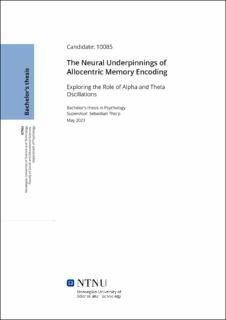| dc.contributor.advisor | Thorp, Sebastian | |
| dc.contributor.author | Ekelund, Skage Christensen | |
| dc.date.accessioned | 2023-07-14T17:20:06Z | |
| dc.date.available | 2023-07-14T17:20:06Z | |
| dc.date.issued | 2023 | |
| dc.identifier | no.ntnu:inspera:146342237:99150751 | |
| dc.identifier.uri | https://hdl.handle.net/11250/3079053 | |
| dc.description.abstract | Allosentriske representasjoner refererer til en form for spatial hukommelse dannet ved å kostruere kognitive kart av omgivelser basert på fremtredende landemerker, uavhengig av individets nåværende eller tidligere opplevd orientering. Ved å analyesere EEG av 30 friske deltakere og å anvende en allosentrisk hukommelsesoppgave, ble det undersøkt om endringer i amplitude innen alpha- og theta-frekvensbåndene indikerer og/eller predikerer vellykket koding av allosentriske representasjoner i en virtuell verden. Resultatene av den nåværende studien indikerer at deltakere som viste høy nøyaktighet av allosentrisk hukommelse, viste høyere amplitude over de fremre og bakre kortikale områdene innen alphabåndet, samt høyere amplitude over frontale og parietale områder innen theta-båndet, sammenlignet med deltakere som viste lav nøyaktighet av allosentrisk hukommelse. Videre ble det funnet at økninger i amplitude innen begge frekvensbåndene kunne predikere nøyaktighet av allosentrisk hukommelse, spesielt over de fremre kortikale områdene. Funnene gjort i denne studien kan bidra til den voksende kunnskapsbasen om funksjonaliteten til nevrale oscillasjoner i hukommelsesprosesser, spesielt relatert til vellykket innkoding av allosentriske representasjoner. I tillegg kan disse resultatene ha praktiske anvendelser innen felt som nevrologi og kognitiv forbedring. | |
| dc.description.abstract | Allocentric representations refer to spatial memories formed by creating cognitive maps of the environment based on salient landmarks, regardless of the individual's current or previous orientation. By recording the EEG of 30 healthy participants and employing an allocentric memory task, the current study examined whether power changes in the alpha and theta frequency bands are indicative and/or predictive of successful allocentric memory encoding in a virtual environment. Results of the present study indicate that participants who displayed high allocentric memory accuracy exhibited higher power values over anterior and posterior cortical regions within the alpha band, as well as higher power values over frontal and parietal regions within the theta band, compared to participants who displayed low allocentric memory accuracy. Furthermore, power increases within both frequency bands were found to be predictive of allocentric memory accuracy, specifically over the anterior cortical regions. The findings of this study may contribute to the growing body of knowledge on the functionality of neural oscillations in memory processes, particularly the successful encoding of allocentric representations. Additionally, these results may have practical applications in fields such as neurology and cognitive enhancement. | |
| dc.language | eng | |
| dc.publisher | NTNU | |
| dc.title | The Neural Underpinnings of Allocentric Memory Encoding: Exploring the Role of Alpha and Theta Oscillations | |
| dc.type | Bachelor thesis | |
